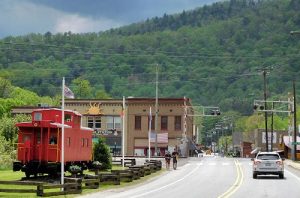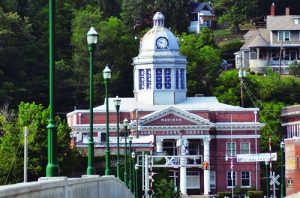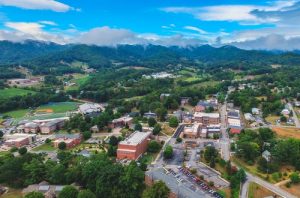Town of Marshall, North Carolina, Visitor Guide
THE CREATIVE LIFE ON THE RIVER
The historic town of Marshall, nestled between rocky cliffs and the scenic French Broad River, celebrates its colorful past while passionately embracing the contemporary. Main Street, lined with original buildings including our century-old courthouse, is home to artists’ studios, galleries, music and dance venues, and eclectic shops. A quick walk or drive over the river takes you to Blannahassett Island, where you’ll find picnic areas, fishing, and the recently restored Marshall High Studios.
HISTORY OF THE TOWN

The French Broad River has helped define the character of the town. Because of its location on this major transportation route–the Buncombe Turnpike, the town was selected to be the county seat and the County Courthouse was constructed in 1907. And, as many other towns throughout the South, Marshall would have a story to tell from the Civil War– The Colonel Allen House. Its setting shaped the town , drawing businesses and people to work in those businesses, creating a thriving economy in the 1900s until Highway 25/70 was rerouted to the “Bypass.” Other historic markers complete the story of its past. The railroad tracks parallel the river between it and Main Street reminding residents and visitors of the town’s economic prime. Today, the town celebrates that history by converting many of the buildings from that time into current use while maintaining architectural integrity of its former appearance. Marshall High Studios on Blannahassett Island are a perfect example of this as the former high school has been converted to use as artists’ studios. The Marshall Downtown Association is an active group committed to promoting the vitality of the town and the events. For details about Marshall’s government, go to the town’s website.
A walk from the north end of Main Street (or Front Street as it was originally called) to the south end of this town, that is “one mile long, one street wide and sky high,” provides a sense of the town’s history. At the far north end is a church that was moved to that location from the island and you will see more churches along this stretch creating a feel of the religious culture of Marshall. The role that the river played in the town’s economic vitality is evident from the railroad tracks paralleling the river–indicating Marshall’s importance for locating businesses which needed proximity to railroads. Not as evident is the old Drover’s Trail that ran along this river as a logical route to transport livestock to market. Marshall is the county seat and its historic 100-year old Courthouse stands as an imposing architectural reminder that the town attracted Richard Sharp Smith (head architect of the Biltmore House) as its designer. In the 1900s there were five automobile dealerships–one of which has been converted to retail space and apartments, attesting to the commitment of residents to return the town to revitalize Main Street and still retain reminders of the past. Download the Marshall Walking Tour (pdf).




